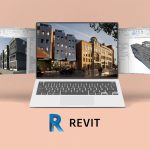Revit is popular building information modeling (BIM) software by Autodesk that’s primarily used by architects, engineers, and building design professionals. It’s used for a variety of tasks, including conceptual design, 3D parametric modeling, design iteration, building performance analysis, and construction documentation.
Revit has revolutionized the way builders and designers approach their work, and it has become an industry mainstay, beloved for its suite of features. If you’re in a relevant business, it’s recommended to maximize the benefits of Revit. But if you’re not adept in its use, hiring Revit designers who can build models and design structures using the software is the best alternative choice.
What Can You Do on Revit?
Revit allows users to create three-dimensional models of buildings and structures. It offers tools for creating floor plans, elevations, sections, and other drawings and properties. Here are some of the tasks that you can accomplish with the software:
- Conceptual design
- 3D parametric modeling
- Design documentation
- Multi-discipline coordinating
- Modeling structure components
- Systems and structures analysis and simulation
- Design iteration and visualization
- Structural steel modeling and documentation
- MEP fabrication modeling and detailing
- Photorealistic 3D visualization
- Building performance analysis
- Construction documentation
How Revit Is Used
Revit is utilized in the architecture, engineering, and construction (AEC) industries. But what is Revit used for exactly? Here are some of the ways the software is used by AEC professionals:
Revit for Architects
Revit enables architects to build 3D models of buildings, allowing them to place real-life components such as walls, doors, and windows into models for more precise designs. It also helps generate floor plans, sections, elevations, schedules, and other details. Architects can render these projects, creating construction documentation, 3D views, and stereo panoramas for better design visualization at the same time.
The program even lets them view models in virtual reality, and because Revit is a multi-discipline platform, it enables architects to share their work with other AEC professionals in real-time, speeding up the design process. Revit also comes with advanced analysis engines and access to performance data, which allows users to optimize the functionality of their designs, run accurate cost estimates, and monitor the performance over the lifecycle of a structure.
Revit for Engineers
Revit has a lot of add-ons and plugins that engineers can use to create 3D reinforcement designs whose elements correspond to real-world objects and materials, making way for a more vivid visualization of plans. The software also allows users to conduct cloud-based structural analysis so they can analyze your models as they work on them.
Revit for Contractors
Why is Revit important in interior design? It’s got a full suite of tools that makes the job of designers and contractors easier, faster, and more precise. With its streamlined engineering design process, contractors can coordinate with architects and engineers through every step of the construction process.
They can use the available features to build mechanical, electrical, and plumbing systems that include architectural and structural components for more precise documentation. Then, they can use these to create fabrication-ready models so they immediately know what they’ll need for production. Contractors can also use Revit to analyze designs; they can conduct simulations and run interference detections to ensure that the final product is safe and sturdy.
What Is a Revit Designer?
A Revit designer is a professional who’s adept and experienced in the use of Revit software to create and analyze 3D building models. They’re primarily responsible for drafting detailed 3D models of structures.
They have a background in AEC and are familiar with building codes, construction methods, and design principles.
Responsibilities of a Revit Designer
The role of a Revit designer varies per project and depending on the client they’re working with. But generally, they take on the following tasks:
- Developing design concepts
- Creating 3D models of buildings and structures using Revit
- Producing construction documentation
- Performing quality control analysis on built models and registered documentation
- Resolving design conflicts and ensuring consistency across disciples
- Collaborating with AEC professionals and other team members to ensure the compliance of project briefs
Hiring a Revit Designer Find the Best Revit Designer on Guru
Every business in the AEC industry will have to work with Revit, so you must have people on your team who have the know-how to maximize its tools and leverage its features. Hiring a freelance Revit designer can bring value to any building project, and Guru has a bounty of vetted Revit professionals who can help you complete related tasks efficiently. Hire a freelance Revit designer on Guru today!



